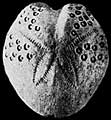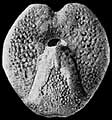The Echinoid Directory
Oppenheimia Cossmann, 1900, p. 186
[pro Lambertia Oppenheim 1899, p. 28 (non Desvoidy, 1863) ]
| Diagnostic Features |
|
|---|---|
| Distribution | Middle and Upper Eocene (Priabonian), North Italy, Hungary. |
| Name gender | feminine |
| Type | Lambertia giardinalei Oppenheim, 1899, p. 28, by original designation. |
| Species Included |
|
| Classification and/or Status |
|
| Remarks |
|



